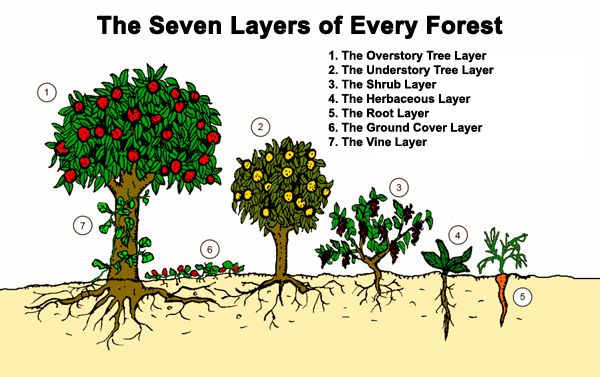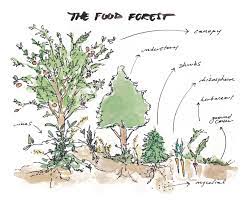Courtesy : permaculturenews.org
Food forest
Why Food Forests?
We’re all familiar with the concept of forests — lush, abundant expanses of pristine wilderness, teeming with life, a richness of biodiversity and awe-inspiring to behold. Trees and plants intertwined, filling every possible space, the very well-spring of life itself!
Forests exist fine on their own. There’s no mowing, weeding, spraying, or digging required. No pesticides, fertilisers, herbicides or nasty chemicals. No work and no people either. They somehow do very well, thank you.
Now, imagine if everything in this lush, abundant, spectacular forest was edible!
If you can imagine what this would look like, if you can picture this in your mind’s eye, then you’re not far from the mark of what a food forest is like in real life.
By understanding how forests grow and sustain themselves without human intervention, we can learn from Nature, copy the systems and patterns to model our own forests — ones filled with trees and plants that produce food we can eat. We can design and construct the most sustainable food production systems possible; perfected, refined and cared for by Mother Nature herself.
If this concept brings up any doubts or scepticism for you as to whether this is something that works in real life, let me reassure you that food forests are a proven concept. Yes, they’re up and running around the world, and they even work in urban areas. I should know, I design and build them!
So, you’re probably wondering how it all works, what the benefits are, whether it’s more productive or cost effective than regular commercial agricultural systems, and so on. Well, we’ll address all these questions and more as we explore the case for food forests in this article, so I welcome you to read on!
Why Forests?
It’s either this…

Or this…. The difference is obvious!

The difference is – LIFE!
Forests are life
- Forests are home to approximately 50-90% of all the world’s terrestrial (land-living) biodiversity — including the pollinators and wild relatives of many agricultural crops (Source: WWF Living Planet Report 2010)
- Tropical forests alone are estimated to contain between 10-50 million species – over 50% of species on the planet.
- Rainforests cover 2% of the Earth’s surface and 6% of its land mass, yet they are home to over half of the world’s plant and animal species.
From these basic facts, it should be evident that forests themselves are synonymous with life, biodiversity and fertility. Where life gathers, complex and mutually beneficial relationships are created between organisms; natural harmonious communities form, and life forms multiply and proliferate.
If forests are where most of the life on the planet is, then anything less than a forest is most likely less suited to supporting life. Life supports life, yet we have forgotten that we are in fact part of the web of life itself, and depend on other life to sustain ours.
Humans tear down forests to create ‘fields’. The word derives from the idea that everything in the area has been ‘felled’ – that is cut down and cleared. In these cleared areas we build cities and farms. How much life and biodiversity do you see in your surroundings day to day compared to what exists in a forest? The answer should be self-evident, and the concept that ‘forests are life’ axiomatic.
Forest facts
- Nature has been growing plants for 460 million years, and trees for 370 million years — Modern humans first appear in the fossil record in Africa about 195,000 years ago.
- Trees once covered nearly all of Earth’s land mass, today they cover about 3.9 billion hectares or just over 9.6 billion acres, which is only about 29.6% of Earth’s total land area.
- Today, there are only three great forests left on Earth: the Amazon Forest of Brazil, and the boreal forests in Russia and Canada.
Trees have been around for much longer than humanity. All the oil and coal we are burning away at a frantic rate was formed from the decomposed remain of ancient forests, millions of years old, which is why they’re called fossil fuels!
We are relative newcomers on this planet, yet we think from the perspective of a single lifetime, and so often from a much shorter time span. Forest have formed a balanced ecosystem that spanned the length and breadth of the planet long before humanity appeared, but now forests are in a pitiful state. What we seem to forget is that these forests were responsible for nursing and rearing all life on this planet at one point or another, and still function as the planet’s life support system.
Forests are the perfect design
- With 460 million years experience, and a 9.6 billion acre garden, Mother Nature has refined the way to grow self sustaining gardens better than anyone! No weeding, spraying or watering!!!
- Nature has supported, fed, clothed and sheltered humanity for 95% of its existence – agriculture only first emerged 10,000 years ago.
- It stands that Nature is obviously the best (and only!) model available for us to imitate for growing gardens.





